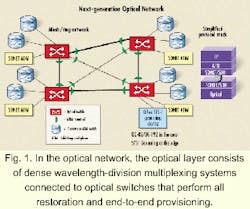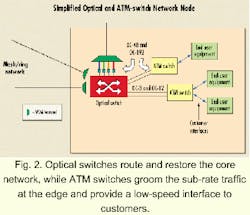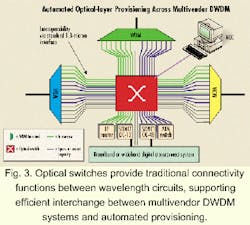How will the optical layer change today's networks?
Optical switches--transparent or opaque--will play an important role in controlling the new wavelength layer in communications networks.
Growing but unpredictable bandwidth demand coupled with increasing tributary and line-rate speeds have created problems for existing network operators and opportunities for emerging providers. Many network operators and equipment suppliers have responded to customers' evolving capacity requirements by adding a wavelength or optical layer to the existing network hierarchy. This wavelength layer is also being sold as services--leased wavelengths, OC-48c (2.5-Gbit/sec) and OC-192c (10-Gbit/sec) bandwidth pipes, and protected OC-N--underscoring the need for low cost and high reliability.
Despite the current debate about where intelligence ought to reside in the network, the wavelength layer still requires all the operations, administration, maintenance, and provisioning functions of traditional electrical layers. To meet these demands and reduce the risk of actual growth significantly deviating from forecasts, most carriers are considering the use of optical switches to manage the wavelength layer just as digital crossconnects have been used to control the electrical layers.
To be effective in this role, optical switches must combine the best features of both Synchronous Optical Network/Synchronous Digital Hierarchy (SONET/SDH) and the digital-crossconnect worlds. They must provide maximum flexibility and scalability with high reliability. Since the wavelength layer is also sold as a service layer, it will require that switches support SONET/SDH network-management features to guarantee service-level agreements and provide efficient maintenance and troubleshooting. In this vein, optical switches must incorporate the broadcast, multicast, and bridging features necessary for restoration and to transmit optical test signals to downstream offices, obviating the need for multiple test sets. To serve as network gateways or regenerators in long dense wavelength-division multiplexing (DWDM) spans, optical switches must also perform full-regeneration functions.
These switches must scale to hundreds of terabits in capacity, with interfaces that range from OC-48 to OC-768 (40 Gbits/sec) and beyond. They must also incorporate the capability to convert electrical switch cores to all-optical switch cores during the next five years if that technology proves reliable and cost-effective. Finally, optical switches will assume the responsibility for optical-layer routing and network-restoration functions at OC-48 and above.
Optical switches that combine these characteristics will deliver tremendous cost savings through flatter architectures, fewer interfaces, and faster restoration and provisioning times. Flat network architectures, flexible protocols, and powerful management systems that automate the optical layer will support on-demand provisioning of high-speed data services and reduce maintenance to a scheduled activity. Fast provisioning coupled with automated restoration are the only ways to address increasing demand and keep network costs falling faster than bandwidth prices.Figure 1 shows the flattened, next-generation, optical-layer network architecture. The optical layer comprises DWDM systems connected to intelligent optical switches that perform all restoration and end-to-end optical-layer provisioning. Internet-protocol (IP) routers, Asynchronous Transfer Mode (ATM) switches, and traditional SONET/SDH grooming devices migrate to the edges of the network to groom traffic for high-capacity pipes. The SONET/SDH Layer 2 functions (sub-rate multiplexing/demultiplexing) are now absorbed into the Application Layer 3 (IP and ATM). The other SONET/SDH Layer 2 functions (restoration, performance management, and fault location) are absorbed into Optical Layer 1, which flattens and simplifies the network architecture.
Given the wide variety of features in optical switches, their applications can vary, ranging from traditional crossconnect functions to new optical-domain needs. However, the primary application migrates most network-restoration functions to the wavelength or optical layer, using optical switches as the major restoration vehicle. This migration pushes traditional SONET/SDH or time-division multiplexing devices to the edges of the network as termination equipment. Optical switches will restore services according to the priority of the service-level agreements in the ring and mesh architectures.Optical switches also provide traditional connectivity functions between wavelength circuits. These devices can support fast, efficient wavelength interchange between multivendor DWDM systems and automated provisioning (see Fig. 3).
This level of automation would not be possible without next-generation switching protocols and network-management systems. There are several new protocols being proposed in a variety of standards bodies for routing and restoring services on the optical layer. All these proposals rely on either assigning a piece of the unused, unassigned SONET/SDH overhead bytes to the optical layer for signaling or adding additional overhead bytes to the overall optical signal (increasing its bit rate by 7% to 8%). However these standards emerge, optical-switch providers will respond with flexible software to adapt to the changes.
To make the network transparent to the operator, network-management systems will integrate functions between the Layer 3 applications and the Layer 1 optics. With SONET/SDH multiplexing and remultiplexing essentially removed from the "ideal" network architecture, this task is significantly less daunting than it may first appear. Several new equipment providers are already building systems to perform such integrated tasks.
This level of automation and service is compelling, but does it really save customers money? Tellium has performed several network-architecture cost studies and comparisons using actual data from regional and national networks. The most striking result? In regional networks, using the optical switch with restoration routes is about half the cost of using traditional sonet/sdh network elements. Since there is additional operational savings with the optical-switch model because of the reduced number of managed elements, these projected cost savings are conservative.
In the case of no restoration, the addition of the optical switches still results in small savings due to the improved grooming of DWDM channels. Therefore, adding optical switching to a network does not necessarily increase costs, even as it adds flexibility and manageability to the network.
National-scale mesh networks are more cost-effective (60% savings) using optical switches, but they make it imperative that the optical layer be self-protected. High-speed mesh restoration becomes a necessity and is made possible by doing the restoration at the optical layer using optical switches. Such restoration can be performed in 50 to 100 msec, compared with the minutes to tens-of-minutes required in today's traditional mesh restoration architectures. The use of optical-layer switching and mesh restoration will be a key factor in providing manageable, high-capacity backbone networks.
While the case for flexibility in the face of uncertainty, cost reduction through simplification of network architectures, and bandwidth management that delivers optical-layer services is clear, how will optical switches meet the daunting challenges proposed? Two primary options for constructing an optical switch are available to equipment manufacturers.
First, an all-optical crossconnect, or "transparent" optical crossconnect, can take advantage of advances in optical-component technology. Transparent all-optical crossconnects have several drawbacks, however. All-optical crossconnects introduce additional cascaded optical impairments. They cannot deliver 3R regeneration. They are costly to use with today's devices. They cannot capture SONET/SDH performance monitoring. They do not deliver sub-50-msec protection switching. And they cannot achieve broadcast capabilities without introducing significant cost, complexity, and performance limitations.
A second option for constructing optical crossconnects is the use of an opaque optical-electrical-optical (O-E-O) conversion. These devices overcome all of the previously mentioned difficulties. Opaque optical switches also offer network operators the low cost, flexibility, scalability, and reliability that they need to manage the optical or wavelength layer.
O-E-O crossconnects will remain state-of-the-art through 2002. However, large-capacity switches (more than 400 Tbits/sec) may have to use an all-optical (transparent) approach. These products might include a micro-electromechanical system (MEMS), or other optomechanical and optical waveguide-based technologies. The industry will watch these technology developments closely to ensure the realization of very large optical-switch products.
As the wavelength layer becomes more dominant, optical switches will be at the heart of every carrier's telecommunications network. These devices will provide both ring and mesh restoration, automated provisioning functions, and gateway and optical-layer on-ramp access, thus truly enabling telecommunications for the new millenium.
Nicholas DeVito is director of marketing and product management at Tellium Inc. (Oceanport, NJ).



